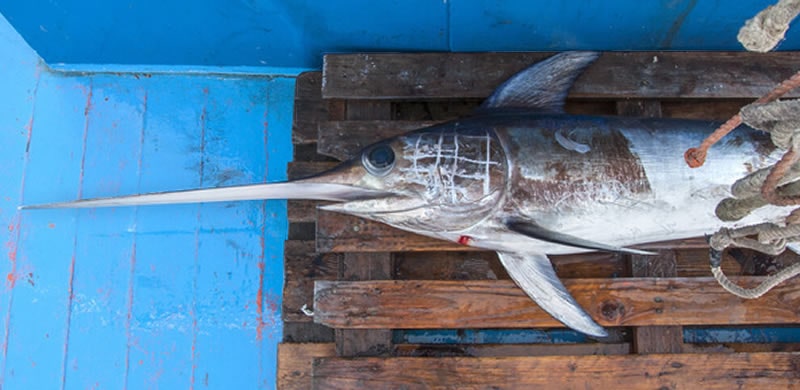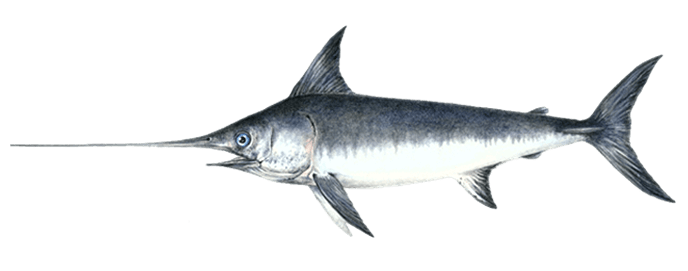Swordfish (Xiphias gladius)
Swordfish are also commonly referred to as Broadbill Swordfish. They are highly migratory species and are one of the most challenging fish to catch in Florida. They are also among the most popular game fish in the world and are abundant in Florida. Swords have large eyes and are usually a dark brown or purplish color on their back that slowly fades to a silvery brown color. They have a very long upper jaw that resembles a sword and are long, wide, and flat. The First dorsal fin is very high and rigid along with a single keel on each side of the caudal peduncle. They have no teeth, scales or pelvic fins. Swordfish are enormous and can grow up to 15 feet and weigh as much as 1,400 pounds. The biggest Swordfish ever caught in Florida was 612 pounds and 12 ounces. This incredible creatures of the sea can swim as fast as 50 mph and live as long as 30 years. Contrary to what most might think the sword it has is not used to stab fish but rather to stun them. Once the bait has been immobilized they will usually come back and eat them whole. Swordfish are excellent eating fish and are heavily overfished internationally because of it. Something you might not know about swordfish is that they have special organs beside there eyes that keep their eyes and brain warm in the cold water they inhabit. They are lone rangers so do not expect to find a school of Swordfish.

How to catch Swordfish in Miami
There are several methods of catching Swordfish in Florida depending on if your daytime swordfishing or nighttime swordfishing. Your going to need a large boat this is capable of going offshore to very deep water. You can also go with on a Florida sailfish fishing charter and they will have plenty of experience and the right gear to land a trophy sailfish at night or during the day. If you’re going on your own make sure your careful as this fish have been reported to attack people in the water, boats, submarines, and even whales. Make sure you have a harpoon or flying gaff on board at all times. You can tie it off to a large poly ball in order to retrieve the fish easier and avoid injury. Just be careful with Mako sharks that can eat your prized fish. At night they tend to be higher in the water column. If you’re trolling at night you want to use a downrigger In order to get your bait down. Regardless if your nighttime or daytime swordfishing you want to use heavy-duty tackle to land this massive fish. Trolling rods with a large 10/0 hook attached to a 15 foot 300lb fluorocarbon leader that is connected with a double uni knot to 100lb braid is highly recommended. You should also use a rod saver just in case the fish rips out the rod from your boat. In the daytime, they are found much deeper so you want to have plenty of lines, a light, and a heavy sinker of around 10 to 15 pounds to get the bait to the bottom. The line should be dropped anywhere between 1,500 and 2,000 feet deep and then reeled in about a 100 feet from the bottom. You want to use a large 9/0 to 11/0 hook on your bait with a glowstick and drift with balloons to help you detect when the Swordfish strikes. For daytime swordfishing you don’t want to have more than one rod in the water otherwise the swordfish can tangle all of your lines while the fish is trying to get away. When you hook a Swordfish they can sometimes go up to the surface to jump and then sprint down at ultrafast speeds to the bottom of the ocean. It is common to use electric reels when fishing for Swordfish to lessen the load, especially in the day. Most people also drift the gulf stream using a Drogues (sea anchor). The sea anchor will slow the boat down and put the boat in the direction of the current. Landing a large Swordfish takes lots of patience and sometimes you can go several days without a bite. Fighting a Sailfish can take anywhere between a couple minutes to 8 hours depending on the size of the fish on the hook. Overall it has always been said that night swordfishing is the most effective but in recent times daytime fishing has become very popular. During daytime swordfishing in Florida the average size fish, you’ll catch is anywhere between 50 pounds and 100 pounds but you can also catch some weighing over 200 pounds occasionally.
Where to fish for Swordfish
Florida is the most popular breeding ground for Swordfish in the world. The estuaries a few miles of the coast of Florida provide great conditions for Swordfish to spawn. The juveniles usually stay around until there three years before migrating. There are plenty of hotspots off the coast of the Florida keys near the Gulf stream. They are hot spots because Swordfish migrate through the Florida Gulf Stream when migrating. The Gulf stream flows northward along the U.S. Continental Shelf and then goes north-east. After that, in late spring they continue in a clockwise direction bringing them right back to their spawning grounds in Florida. Where to fish for Swordfish in Florida largely depends on if your fishing at night or during the day. They prefer water temperature anywhere between 41 degrees and 81 degrees. At night when the water is cooler, you can catch larger Swordfish that are over 200 lbs because they come closer to the surface. They can often be found feeding in water as shallow as 500 feet. In the daytime, they are usually found below 1,500 feet. If you go out on a daytime swordfish charter, Captains will usually take you anywhere between 20miles to 50 miles off of Islamorada in water depths between 1,500 feet to 2,000 feet of water. You’ll need lots of patience and plenty of line with heavy weights to get the bait down to the fish. A glowstick and a heavyweight is also a necessity. When daytime fishing for Swords having an electric reel will save you from hours of having to bring in the line to check the bait. On rare occasions, they can sometimes leap out of the water during the day in an attempt to shake off unwanted parasites that latch on to them. A popular place to find Swordfish is in the Straights of Florida or the middle the Gulfstream. The gulf currents push fry, zooplankton, and various of other bait fish that provide an abundant food source for Swordfish. They can be found from West Palm Beach all the way down to Key West. They spawn in the Caribbean and then the down current floats the fry toward the east coast of Florida. Swordfish can be caught anywhere off the coast of Florida, but eastern Florida in the Gulf stream and Florida straights provide some of the best fishing grounds for catching Swordfish. They also come here for the protection from Mako sharks and other large predators that feed on smaller Swordfish. They frequent geographical formations on the ocean floor, so look for valleys, ocean trenches, underwater canyons and hills on your fish finder where currents push threw bringing large amounts of bait fish. These spots near the continental shelf are excellent places to catch Swordfish. The continental slope near Islamorada has steep drop-offs which make them good places to fish. Swordfish are pelagic feeders that swim from the bottom of the ocean to the surface and cover long distances.These fish are a highly migratory species so anchoring is not required. Just miles off the coast of Miami in 1500 feet or more there are also blue waters with plenty of structure that attract juvenile and adult swordfish. If you are further up north then you can also find them off the coast of Fort Lauderdale, Stuart, Destin, and West Palm Beach.
Best time of the year for Miami Swordfish fishing
Swordfish can be found year-round in Florida but adults mainly congregate during the months of April and May to spawn. The best time of the year to fish for Swordfish in Florida is from the beginning of August till the end of November. It has long been thought that fishing for Swordfish was a nighttime affair but recent advancements in fishing tackle and floor scanning sonars have made it much easier to find these fish in the daytime. At night blind trolling in water between 500 feet and 1,500 feet is a great place to start. You can also find them in reefs and other structures where there is a lot of activity. In the daytime, you want to target underwater structures in much deeper water anywhere between 1,500 feet and 2,500 feet of water.
The best bait to catch Swordfish
Setting out a chum line is a great way to attract baitfish and cause some commotion which in turn will attract Swordfish. They prefer live baits like Tinker Mackerel. small Bonita and Blue runners. If you can find them then Tinker Mackeral is said to be the best bait to catch Swordfish. They will also go after dead baits such as Mullet, Herring, Bonito, Goggle-Eyes, Mackerel, Squid, Eels, Blue runners, squid barracuda, ballyhoo, Redfish, Deepwater cape hake, and Filefish. Using a squid dredge is also recommended if you’re trolling for Swordfish at night. The dredge creates the illusion that there is a school of squid chasing the boat and attracts much more attention to your boat.
Can you eat Swordfish?
Swordfish are very tasty fish and are the best eating billfish of the bunch. They have a mildly sweet and buttery flavor profile. They have a moist, firm meaty texture with moderately high-fat content and are mildly flavorful. Due to their large size, the most common method to fillet this fish is by “steaking” it. When cooking swordfish steaks you should leave them medium rare and be careful not to overcook them. Common methods of cooking swordfish are broiled, baked, poached, sautéed, stir-fried, and even raw as sashimi. Billfish have some of the highest concentrations of mercury and other toxins that can be harmful to humans so you should not eat swordfish frequently. For children and pregnant or nursing mothers, you should avoid eating any type of billfish at all cost including Swordfish. Make sure you get a Federal HMS Angling Permit before catching and keeping a Swordfish or your tasty dinner can turn out to be the most expensive fish you’ve ever reeled in.
Florida Swordfish fishing regulations
If your lucky enough to catch a Swordfish make sure it measures over 47 inches from the lower jaw to the fork and at least 25 inches from the cleithrum to the keel. There is no closed season so they can be caught year round in Florida. You are allowed to keep one per angler but cannot exceed 4 per boat. It doesn’t matter if you were out in the water for a couple of days when you come in you cannot have more than four on your boat. If your fishing on a charter boat you are not allowed to keep any swordfish you catch. If you already have a Florida saltwater fishing license you will also need to make sure to purchase a Federal HMS Angling Permit required to catch billfish in Federal waters. If you are fishing in state waters then you are not required to have the permit. Any billfish or swordfish you bring onto land must be reported to NOAA within 24 hours at 800-894-5528 or https://hmspermits.noaa.gov. They cannot be caught with anything other than hook and line. If the Swordfish you catch is bitten by a Mako shark on the way in you may retain the remainder of the carcass if it is at least 47 inches from the lower jaw fork or 25 inches from the cleithrum to keel. You are allowed to remove the head and gut the fish at sea.












